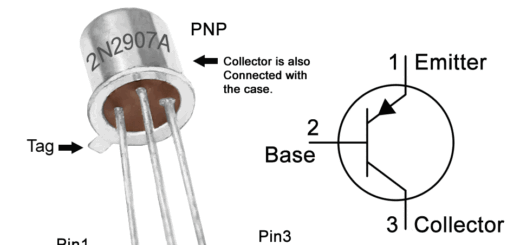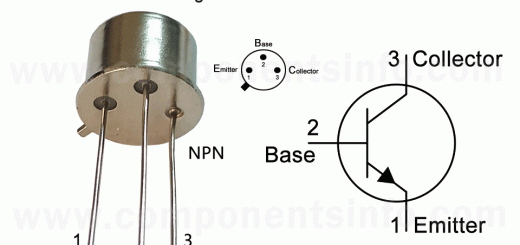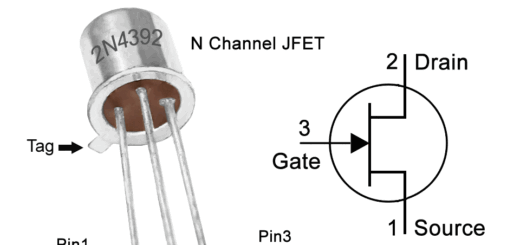BD684 Transistor Pinout, Equivalents, Features, Applications and Other Related Information
BD684 is another PNP transistor from BD6xx TO-126 Darlington transistor series. Today we are going to explore BD684 transistor pinout, equivalents, features, applications and other related information.
Absolute Maximum Ratings:
- Package Type: TO-126
- Transistor Type: NPN Darlington
- Max Collector Current(IC): –4A
- Max Collector-Emitter Voltage (VCEO): –120V
- Max Collector-Base Voltage (VCBO): –120V
- Max Emitter-Base Voltage (VEBO): –5V
- Max Collector Power Dissipation (Pc): 40 Watt
- Minimum DC Current Gain (hFE): 750
- Max Storage & Operating temperature: -65 to +150 Centigrade
NPN Complementary:
NPN Complementary of BD684 is BD683
Replacement and Equivalent:
BD338, 2SB1113, 2SB1490, 2SB1253, 2SB1254, MJE702, MJE703, MJE802, MJE803
BD684 Transistor Explained / Description:
BD684 is a PNP Darlington transistor manufactured in TO-126 package. A Darlington transistor is a transistor that contains two transistors inside which are connected in such a way (Shown in the pinout image above) that increases the gain of the input signal to a great extent.
BD684 is a transistor of BD6xx series which also contains other transistors such as BD676, BD678, BD680, and BD682. All these transistors can be used as alternatives if your load’s operating requirements are below from the transistor you are using as an alternative. For example, if your load requirements are more than 45V then you cannot use BD676 as a replacement and you have to replace it with BD678 which is capable to drive load of upto 60V.
Looking at the absolute maximum ratings of the transistor the collector-base voltage of the transistor is -140V, collector-emitter voltage is -120V, emitter-base voltage is -5V, base current is -0.1A, collector current is -4A and collector power dissipation is 40W.
Now looking at the pin layout of the transistor as shown in the image above when the first pin is emitter, second is collector and third is base.
The transistor is designed to be used in video and audio output circuitry and switching circuits but can also be used in a variety of other applications which are mentioned under the applications heading below.
Where We Can Use it & How to Use:
As already discussed the transistor is designed to use in video and audio output and switching circuits but can also be used in other applications such as controllers, drivers, voltage converters, supplies, etc.
To use the transistor first of all check its pinout after that if you want to use it as a switch then connect its emitter with the positive supply and base with the signal you want to drive the load and connect the collector with the positive connection of the load and the negative connection of the load will be connected to the negative rail of the circuit.
To use the transistor first check its pinout after that it depends on how you want to use it such as a switch or amplifier. Using the transistor as a switch is straight forward for doing so connect its emitter with the negative supply, its collector with the negative supply of the load, and the load’s positive wire will be connected with the positive rail of the circuit. The base of the transistor will be connected with the signal you want to drive the load.
The transistor can also be used as an amplifier but it is important to consider which type of audio amplifier you require because there are many different types of amplifiers you can build with a transistor. So here we are discussing a simple one transistor amplifier, first of all connect the emitter pin of the transistor with the positive supply, base of the transistor will be connected with the signal you want to amplify through a 1n filter capacitor and collector of the transistor will be will also be connected through a 1n filter capacitor to a sound producing device such as a small speaker or headphone, but it should be noted that this is a simple type of amplifier and to make it produce better sound you have to use additional resistor and capacitors.
Applications:
Power Supplies
Motor Control
Switching Circuits
DC to DC Converters
Audio Amplifiers
Voltage inverters
LED Drivers
Voltage Regulation
Pulse Generator
Battery Operated Applications
Safe Operating Guidelines:
Here are the safe operating guide for the transistor.
- Do not use the transistor to its maximum limits and always stay 20% below from its max ratings.
- The maximum load this transistor is capable to drive is 4A but as the 20% below rule you should not drive load of more than 3.2A.
- The maximum load voltage limit of the transistor is -120V so do not drive load of more than -96V.
- The transistor should not be exposed to temperatures below -65°C and above 150°C.
Datasheet:
To download the datasheet just copy and paste the below link in your browser.
https://datasheetspdf.com/pdf-down/B/D/6/BD684-InchangeSemiconductor.pdf



